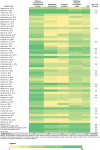Quality indicators for the primary prevention of cardiovascular disease in primary care: A systematic review
- PMID: 39637114
- PMCID: PMC11620663
- DOI: 10.1371/journal.pone.0312137
Quality indicators for the primary prevention of cardiovascular disease in primary care: A systematic review
Abstract
Background: Primary care is usually the entry point for preventing cardiovascular disease (CVD). Quality indicators can be used to assess and monitor the quality of care provided in a primary care setting. In this systematic review, we aimed to identify, summarise, and assess the methodological quality of indicators reported in the articles for the primary prevention of CVD in primary care.
Methods: We searched Ovid MEDLINE, Ovid EMBASE, CINAHL Plus, SCOPUS, and grey literature for articles containing quality indicators published in English language. Quality indicators were categorised using the Donabedian framework: Structure (organisation of care), Process (assessment of metabolic risk factors, global risk assessment, lifestyle management, prescription of medications, risk communication/advice, referral), and Outcome (attainment of risk factor targets). Articles were reviewed by two authors, using the Appraisal of Indicators through Research and Evaluation (AIRE) instrument, where a score of ≥50% for each domain indicated strong methodological quality (e.g., stakeholder involvement).
Results: We identified 282 articles for full-text review; 57 articles were included for extraction. A total of 726 (681 unique) quality indicators were extracted. Three out of four (76%) were process indicators (56 articles), followed by 15% outcome indicators (40 articles), and 9% structure indicators (12 articles). One-third of process indicators were related to the assessment of metabolic risk factors (222/726 indicators, 41 articles), followed by lifestyle management (153/726 indicators, 39 articles), prescription of medications (122/726 indicators, 37 articles), and global risk assessment (27/726, 14 articles). Few indicators were related to risk communication/advice (20/726 indicators, 7 articles) and referral (9/726 indicators, 6 articles). Only 26/57 (46%) articles were found to have strong methodological quality.
Conclusion: We summarised and appraised the methodological quality of indicators for the primary prevention of CVD. The next step requires prioritising a minimum set of quality indicators to encourage standardised collection and monitoring across countries.
Copyright: © 2024 Bam et al. This is an open access article distributed under the terms of the Creative Commons Attribution License, which permits unrestricted use, distribution, and reproduction in any medium, provided the original author and source are credited.
Conflict of interest statement
Dominique A Cadilhac received restricted grants from Boehringer Ingelheim, Moleac, Amazon Web Services, Nicolab, Philips and Medtronic; outside the submitted work. This does not alter our adherence to PLOS ONE policies on sharing data and materials.
Figures
Similar articles
-
Quality indicators for lifestyle or behavioural management for the primary prevention of cardiovascular disease in primary care: a systematic review.BJGP Open. 2025 May 13:BJGPO.2025.0018. doi: 10.3399/BJGPO.2025.0018. Online ahead of print. BJGP Open. 2025. PMID: 40360193
-
Beyond the black stump: rapid reviews of health research issues affecting regional, rural and remote Australia.Med J Aust. 2020 Dec;213 Suppl 11:S3-S32.e1. doi: 10.5694/mja2.50881. Med J Aust. 2020. PMID: 33314144
-
Mediterranean-style diet for the primary and secondary prevention of cardiovascular disease.Cochrane Database Syst Rev. 2019 Mar 13;3(3):CD009825. doi: 10.1002/14651858.CD009825.pub3. Cochrane Database Syst Rev. 2019. PMID: 30864165 Free PMC article.
-
Quality indicators for care of osteoarthritis in primary care settings: a systematic literature review.Fam Pract. 2018 Mar 27;35(2):151-159. doi: 10.1093/fampra/cmx090. Fam Pract. 2018. PMID: 28973146 Free PMC article.
-
Mobile phone-based interventions for improving adherence to medication prescribed for the primary prevention of cardiovascular disease in adults.Cochrane Database Syst Rev. 2021 Mar 26;3(3):CD012675. doi: 10.1002/14651858.CD012675.pub3. Cochrane Database Syst Rev. 2021. PMID: 33769555 Free PMC article.
Cited by
-
Implementation of Pharmacist Case-Finding and Care Pathway Intervention for Vascular Prevention (PRxOACT): Protocol for a Randomized Controlled Trial.CJC Open. 2025 Mar 20;7(6):821-831. doi: 10.1016/j.cjco.2025.03.011. eCollection 2025 Jun. CJC Open. 2025. PMID: 40586019 Free PMC article.
References
-
- Vaduganathan M, Mensah GA, Turco JV, Fuster V, Roth GA. The global burden of cardiovascular diseases and risk: a compass for future health. American College of Cardiology Foundation Washington DC; 2022. p. 2361–71. - PubMed
-
- World Health Organization. Cardiovascular diseases (CVDs) Key Facts 2022. https://www.who.int/news-room/fact-sheets/detail/cardiovascular-diseases....
-
- Arnett DK, Blumenthal RS, Albert MA, Buroker AB, Goldberger ZD, Hahn EJ, et al.. 2019 ACC/AHA guideline on the primary prevention of cardiovascular disease: executive summary: a report of the American College of Cardiology/American Heart Association Task Force on Clinical Practice Guidelines. Circulation. 2019;140(11):e563–e95. doi: 10.1161/CIR.0000000000000677 - DOI - PMC - PubMed
Publication types
MeSH terms
LinkOut - more resources
Full Text Sources




